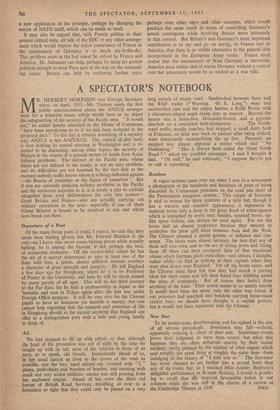A .1.
We had stopped to fill up with petrol, so that, although the head of the procession was out of sight by the time we caught up with its tail, most of the vehicles in front of us were, so to speak, old friends. Immediately ahead of us, in her usual station as close to the crown of the road as possible, was the tiny, aged saloon' car, covered with " L " plates, push-chairs and bunches of heather, and bursting with small and very active children; smoke was still pouring from her starboard engine. Ahead of her were the three red lorries of British Road Services, travelling as ever in a formation so tight that they could only be passed on a very long stretch of empty road. Sandwiched between them and the RAF trailer (" Warning. 60 ft. Long.") were two unidentified cars and the empty hearse, a Rolls Royce with a chromium-plated angel doing duty as mascot. Beyond the hearse was a horse-box, Doncaster-bound, and a gigantic elm-butt on a converted tank-transporter. . . . The North- ward traffic, mostly coaches, had stopped; a small dairy herd of Friesians, on their way back to pasture after being milked, were temporarily monopolising the up line. Presently we stopped too, almost opposite a . notice which said " No Overtaking." " Has it always been called the Great North Road ? ". asked my youthful passenger. I said I thought it had. " Oh well," he said tolerantly, " I suppose they've got to call it something.'


































 Previous page
Previous page